
Syntax: expires [time|epoch|max|pff] Default value: offexpires directive controls the "expires" and "cache-control" header information in the http response, and starts the function of controlling the page cache time: you can use the correct number or negative number. The value of the "expires" header will be set by adding the current system time to the set time value. The time value also controls the value of "cache-control": a negative number indicates no-cache, a positive number or zero indicates max-age=time epoch: Specify the value of "expires" as 1january,1970,00:00:01 gmtmax: Specify "expires" "The value of "cache-control" is 31december2037 23:59:59gmt, and the value of "cache-control" is 10 years. -1: Specify the value of "expires" to be -1s of the current server time, which means it will expire forever. off: Do not modify the values of "expires" and "cache-control"
expires uses a specific time and requires strict synchronization between the server and the client.
The cache-control uses the max-age directive to specify how long the component will be cached.
For browsers that do not support http1.1, expires still need to be controlled. So it's best to specify two response headers. But the http specification stipulates that the max-age directive will rewrite the expires header.
If you do not want the proxy or browser to cache, add the no-cache parameter or private parameter:
# expires 1d;
add_header cache-control no-cache;
add_header cache-control private ;
In this way, when the browser f5 is refreshed, the returned value is still 200, not 304.
Record an example of nginx controlling cache:
cache;
add_header cache-control private;
if ( !-e $request_filename) {
rewrite ^(.*) http://test.zhaopin.com/index.html break;
# add_header cache-control no-cache;
# add_header cache-control private;
When I wrote add_header after rewrite, I found that add_header did not work. . It is because it is written into the if..
apache's mod_expires module enables the date to be set in a relative manner like max-age when using the expires header, which is completed through the expiresdefault directive. For example: the expiration time of pictures etc. is 10 years after the request started.
expiresdefault "access plus 10years"
It sends expires header and cache-control max-age header in the response.
expires|etag controls the page cache. The difference expires: As mentioned in the above article: the expires directive controls the "expires" and "cache-control" header information in the http response, and starts the function of controlling the page cache time. :Positive or negative numbers can be used. The value of the "expires" header will be set by adding the current system time to the set time value. The time value also controls the value of "cache-control": a negative number indicates no-cache, a positive number or zero indicates max-age=time epoch: Specify the value of "expires" as 1january,1970,00:00:01 gmtmax: Specify "expires" "The value is 31december203723:59:59gmt, and the value of "cache-control" is 10 years. -1: Specify the value of "expires" to be -1s of the current server time, which means it will expire forever. off: Do not modify the values of "expires" and "cache-control"
expires uses a specific time and requires strict synchronization between the server and the client.
The cache-control uses the max-age directive to specify how long the component will be cached.
For browsers that do not support http1.1, expires still need to be controlled. So it's best to specify two response headers. But the http specification stipulates that the max-age directive will rewrite the expires header. It is generally used when the page does not change very quickly. If the cache expires, the browser will first confirm whether it is valid before reusing it. It is a "conditional get request". If it is valid, it will return a 304 status code. Expirations are determined via the last-modified response header. As shown in the picture:
First visit:
Request: 
Return: 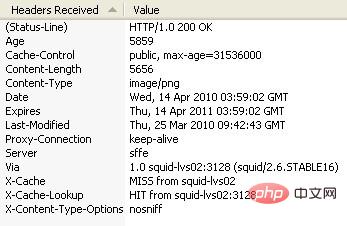
Second visit:
Request: 
Return: 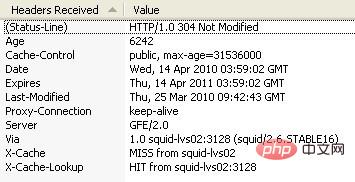
The status code returned at this time is 304, and there are more if-modified in the request than the first time The -since header is compared with the last-modified in the original server, so browser caching is implemented and whether it is expired is determined.
To put it simply, last-modified and if-modified-since are both http header information used to record the last modification time of the page, but last-modified is the http header sent by the server to the client, while if-modified-since is From the header sent by the client to the server, you can see that when requesting a locally existing cache page again, the client will send back the last-modified last modification timestamp sent by the previous server through the if-modified-since header. This It is for the server to perform verification and use this timestamp to determine whether the client's page is the latest. If it is not the latest, new content will be returned. If it is the latest, 304 will be returned to tell the client that the page in its local cache is the latest. , so the client can load the page directly from the local, which will greatly reduce the data transmitted on the network and also reduce the burden on the server.
If you do not want the proxy or browser to cache, add the no-cache parameter or private parameter:
# expires 1d;
add_header cache-control no-cache;
add_header cache-control private ;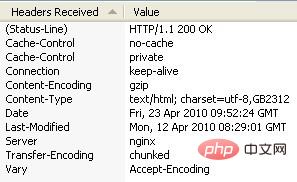
etag: Entity tag is a mechanism used to confirm the validity of web server and browser caches. The origin server uses the etag response header to specify the component's etag and the browser passes the etag back to the origin server via the if-none-match header. If it matches, return 304
as shown:
First visit:
Request: 
Return: 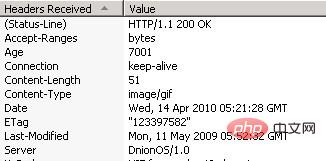
Second request: 
Return: 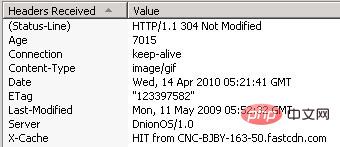
The status code still returned is 304, and there are more ifs in the request than in the first time -none-match header. So implement browser caching. If this value does not match, the cache expires.
etags and if-none-match are a commonly used method to determine whether a resource has changed. Similar to last-modified and http-if-modified-since. But the difference is that last-modified and http-if-modified-since only determine the last modification time of the resource, while etags and if-none-match can be any attribute of the resource.
The working principle of etags and if-none-match is to add etags information in httpresponse. When the client requests the resource again, the if-none-match information (the value of etags) will be added to the httprequest. If the server verifies that the resource's etags have not changed (the resource has not changed), it will return a 304 status; otherwise, the server will return a 200 status and return the resource and the new etags.
The etag format on iis needs to be modified.
The above is the detailed content of nginx expires method to control page caching. For more information, please follow other related articles on the PHP Chinese website!
 nginx restart
nginx restart
 Detailed explanation of nginx configuration
Detailed explanation of nginx configuration
 Detailed explanation of nginx configuration
Detailed explanation of nginx configuration
 What are the differences between tomcat and nginx
What are the differences between tomcat and nginx
 How to solve the problem that wlan does not have a valid ip configuration
How to solve the problem that wlan does not have a valid ip configuration
 The difference between ms card and sd card
The difference between ms card and sd card
 index.html what is
index.html what is
 mongodb startup command
mongodb startup command




